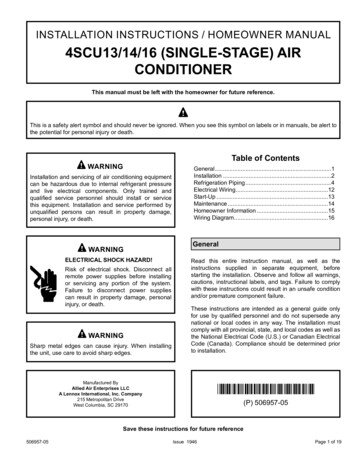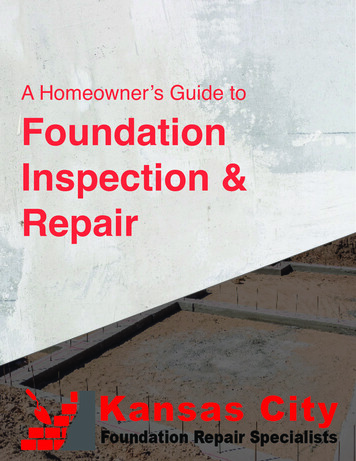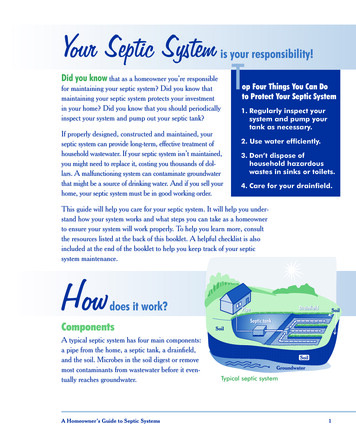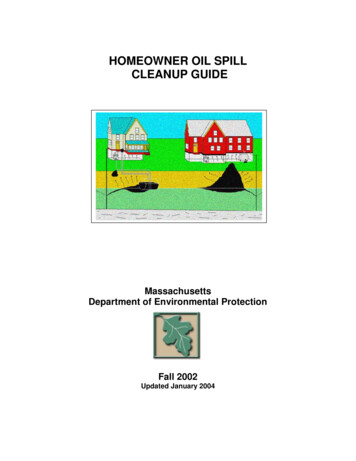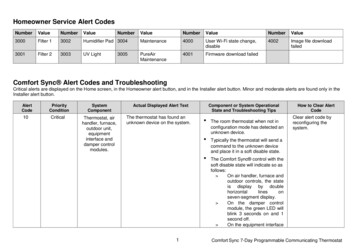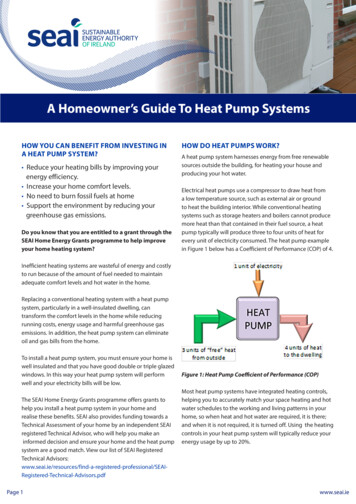
Transcription
A Homeowner’s Guide To Heat Pump SystemsHOW YOU CAN BENEFIT FROM INVESTING INA HEAT PUMP SYSTEM? Reduce your heating bills by improving yourenergy efficiency. Increase your home comfort levels. No need to burn fossil fuels at home Support the environment by reducing yourgreenhouse gas emissions.Do you know that you are entitled to a grant through theSEAI Home Energy Grants programme to help improveyour home heating system?HOW DO HEAT PUMPS WORK?A heat pump system harnesses energy from free renewablesources outside the building, for heating your house andproducing your hot water.Electrical heat pumps use a compressor to draw heat froma low temperature source, such as external air or groundto heat the building interior. While conventional heatingsystems such as storage heaters and boilers cannot producemore heat than that contained in their fuel source, a heatpump typically will produce three to four units of heat forevery unit of electricity consumed. The heat pump examplein Figure 1 below has a Coefficient of Performance (COP) of 4.Inefficient heating systems are wasteful of energy and costlyto run because of the amount of fuel needed to maintainadequate comfort levels and hot water in the home.Replacing a conventional heating system with a heat pumpsystem, particularly in a well-insulated dwelling, cantransform the comfort levels in the home while reducingrunning costs, energy usage and harmful greenhouse gasemissions. In addition, the heat pump system can eliminateoil and gas bills from the home.To install a heat pump system, you must ensure your home iswell insulated and that you have good double or triple glazedwindows. In this way your heat pump system will performwell and your electricity bills will be low.The SEAI Home Energy Grants programme offers grants tohelp you install a heat pump system in your home andrealise these benefits. SEAI also provides funding towards aTechnical Assessment of your home by an independent SEAIregistered Technical Advisor, who will help you make aninformed decision and ensure your home and the heat pumpsystem are a good match. View our list of SEAI RegisteredTechnical age 1Figure 1: Heat Pump Coefficient of Performance (COP)Most heat pump systems have integrated heating controls,helping you to accurately match your space heating and hotwater schedules to the working and living patterns in yourhome, so when heat and hot water are required, it is there;and when it is not required, it is turned off. Using the heatingcontrols in your heat pump system will typically reduce yourenergy usage by up to 20%.www.seai.ie
A Homeowner’s Guide To Heat Pump SystemsTYPES OF HEAT PUMP SYSTEMSDifferent types of heat pump systems draw heat fromdifferent sources: air, water or the ground. Heat generated isdistributed via radiators, underfloor heating or warm airunits. Heat pump systems will heat radiators to a lowertemperature than conventional boiler systems, and this workswell when the home is well insulated. Heat pump systems,excluding those providing warm air to the home, can supplymost of the hot water needed for baths, showers and sinks.Air Source: The most common heat pump systems extractheat from external air, typically using an outside unit suchas that shown in Figure 2. These heat pump systems do notrequire underground piping to source heat and so can becheaper and easier to install compared to ground source heatpump systems. Air to water heat pump systems are the most popularchoice of system. Heat is distributed through radiatorsand underfloor heating and they can also produce hotwater. Exhaust-air to water heat pump systems are similar toair to water but include mechanical extract ventilationand recover heat from air drawn from the dwelling. In Air to air heat pump systems the heat is distributedthrough air units. Air to air heat pump systems do notprovide hot water.A very comprehensive guide to ground and water sourceheat pump systems, published by the Geological Survey ofIreland, is available at this l.pdfWater source heat pump systems use open water (lakes,rivers or streams) as a heat source. While ground and watersource heat pump systems have the extra complexity andcost of installing the collector pipework to draw heat fromthe ground or water, they can have more consistentperformance than air source heat pump systems, even incolder weather.Note: Regardless of the type of heat pump system youchoose, it is important to note that you will need leaveyour heat pump switched on for long periods of time tomake sure that it performs well and operates mosteconomically.Figure 3: Heat pump installations sourcing heat from theground and from waterSome heat pump systems, such as those requiring the useof oil or gas, or those providing only hot water, cannot availof the SEAI grant. Please check with your contractor and, ifin any doubt, call the Home Energy Grants Helpdesk on 018082100.HOW DO I CHOOSE?Figure 2: Air Source Heat Pump Outdoor UnitGround Source and Water Source: Ground source andwater source heat pump systems are less common thanair source units. A ground source heat pump system, alsoknown as a geothermal heat pump system, uses the earth asa source of renewable heat. Heat is drawn from the groundthrough collector pipework and transferred to the heatpump. The ground collector can be laid out horizontally at ashallow depth below the surface or else vertically to a greaterdepth.Page 2Selection of the right type of heat pump system can oftendepend on practical and budgetary limitations. Many peoplechoose air source heat pump systems as they need relativelylittle space. If you have a large garden or are near a watersource you may choose a ground source or water source heatpump. SEAI Registered Heat Pump Contractors andindependent SEAI registered Technical Advisors can help youmake the right choice. They will outline the pros and cons ofeach type of heat pump system.www.seai.ie
A Homeowner’s Guide To Heat Pump SystemsENSURE YOUR HOME AND HEAT PUMPSYSTEM ARE A GOOD MATCH: GETTINGSTARTEDHeat pump systems are at their most efficient and effectivewhen generating heat at a lower temperature. On this basis,one of the requirements for a dwelling to qualify for anSEAI Home Energy grant for a heat pump system is that thedwelling has low heat loss. Some of the measures that canhelp achieve this are insulation upgrades such roof and wallinsulation upgrades, which are grant aided under SEAI’sHome Energy Grants programme. Good insulation is neededto reduce draughts in the home and eliminate heat lossesthrough open chimneys, which will affect the performance ofyour heat pump system.To help achieve this in your home, you must engage anindependent SEAI registered Technical Advisor beforeapplying for the heat pump system grant. They will carry outa technical assessment and Building Energy Rating on thehouse before guiding you on the energy performance of thedwelling, particularly on the suitability of the dwelling for aheat pump system, based on the dwelling’s heat loss. Theywill provide you with independent guidance on measuresthat may be necessary to ensure that the dwelling fabric heatloss is lowered to an acceptable level for a heat pump systemto perform at its best.A dwelling with poor insulation and single glazing could costsubstantially more to upgrade to the necessary level than,say, a well-insulated dwelling with newer double glazing.The Technical Advisor can also help you understand the typesof heat pump systems available and the options mostsuitable for your dwelling, before you talk in more depth to aheat pump contractor. It is worth discussing home upgradeswith friends and family who may have already carried out themeasures to give you a better insight into the advantages,improvements and possible issues they experienced whenupgrading their own homes. You should visit an existing heatpump system before proceeding with the installation.Note: To qualify for the Technical Assessment grant and theHeat Pump grant, you must carry out the recommended fabricupgrades to ensure your home meets the required heat lossindicator, thus ensuring your heat pump system performsefficiently and effectively. Failure to meet this requirement willresult in both grants being declined. The recommended fabricupgrades may be undertaken prior to, or in conjunction with,installation of the heat pump system. Multiple upgrademeasures may be included in a single grant application.Page 3QUESTIONS TO ASK YOUR SUPPLIER ANDCONTRACTOROnce the Technical Assessment is done, it’s time to engagean SEAI registered Heat Pump contractor to install the heatpump system. Depending on recommendations from theSEAI registered Technical Advisor, you may also need tocontact one of SEAI’s registered insulation contractors. Checkout our other Homeowner Guides on grant funded fabricmeasures n-grantsAll SEAI registered contractors follow an approach using highquality workmanship and products ensuring the rightstandards and regulations are followed for all grantmeasures. It is worthwhile talking to a few differentregistered contractors, so you have a better understanding ofthe options available to you and typical costs. Discussionwith contractors can also give better insight into likelyadditional costs (such as additional electrical works orreplacement of existing heat distribution systems withunderfloor heating or low temperature radiators).SEAI has compiled a list of questions you should ask yoursuppliers and contractors prior to going ahead with the heatpump system purchase. Your Technical Advisor may also helpyou to identify other useful questions for the heat pumpcontractor. It is in your best interest to make sure you aresatisfied that all your questions are answered. If an answerseems too complicated, then ask for a simpler explanation. Ifsomeone is selling you a heat pump system, they will behappy to provide an explanation to your satisfaction.EQUIPMENT1.2.3.4.5.6.7.Is this heat pump type eligible for SEAI Home EnergyGrants funding?Does it meet SEAI’s grant specifications in terms ofcertification, CE marking and other relevant standards?Does the system exceed SEAI’s heat pump efficiencyrequirements? By how much?What are the heat source options for my dwelling, e.g. airsource vs. ground source?Do I need a new heat distribution system (e.g. lowtemperature radiators) or can I use what I have already?How noisy is the system in operation? Will it be locatednear doors or windows?Will the heat pump be located close to the house toensure optimum efficiency of the pump?www.seai.ie
A Homeowner’s Guide To Heat Pump Systems8.Is the heat pump being located near to salineenvironments? If so, discuss treatment options with yourinstaller to ensure against rust.9. What kind of controls will the system have, e.g. time andtemperature regulation, zoned heating, weather andload compensation?10. Will the programmer be user-friendly and easy tore-programme, should my schedule change in thefuture?11. Will the supplier provide instruction and demonstrationon how the installed controls work?12. Do all system components meet manufacturer’sspecifications?SIZING AND DESIGN1. Does the heat pump system need backup for spaceheating or water heating even in colder outdoorconditions? Grant funded systems must be designed tomeet 100% of the dwelling space heating demand andat least 80% of the hot water demand. Hot water requiresa higher temperature than space heating so may requiresome backup heating to reach adequate temperatures.2. Is the system sized correctly? Will it meet demand andhas the system designer allowed for fabric upgraderecommendations from the Technical Advisor to ensurethe system isn’t oversized?3. Is the heat source system (e.g. ground loop or externalfan) sized and designed to ensure best performance bythe heat pump system?4. Is the heat pump system design according tomanufacturer’s specifications?5. Are there any specific requirements regardingelectrical connection, e.g. 3-phase or night rateconnection, distribution board or wiring upgrades? Whatare the resulting cost implications, and who is carryingout this work? Are they qualified to do so?6. How much space is required for the heat pump systeminside and outside?7. Are there landscaping or planning restrictions,particularly in the case of the ground/water source heatpump? For example, is there space for the heatcollector or is there a need to remove trees/roots whichcould damage the collector over time?8. Has the contractor contacted the EPA to ensure relevantrequirements are met if a water source or vertical groundsource heat pump system is being proposed?Page 4INSTALLING AND COMMISSIONING1. Does the contractor offer system design, delivery,installation, commissioning and after sales service?2. Does the contractor meet SEAI’s competencerequirements for Better Energy Homes registered HeatPump contractors and are they registered as such?Registration is mandatory for the grant to be obtained.3. How many years has the contractor been installing heatpump systems? How many systems have they installed?Are any available for viewing locally?4. Have they been trained by the manufacturer to installthis heat pump system?5. Is the contractor a member of any relevant tradeassociations or professional organisations?6. Will any of the installation be sub-contracted and who isultimately responsible for the work?7. How long does installation take?8. Is there provision for appropriate access to the heatpump, manifolds etc. for maintenance purposes?9. What is the commissioning procedure and who signs offon the heat pump installation?10. Who is responsible for making good any disruption tothe inside and outside of the dwelling and the groundsof the dwelling?11. Is there a site plan and plans for piping and wiring?12. Is there a contract detailing the above information alongwith a cost quotation?OPERATION AND MAINTENANCE1. Can you ensure that the homeowner will be providedwith all required performance data and documentation,so the grant can be claimed successfully? Thisdocumentation must also meet BER requirements, so thepost-works BER can reflect the performance of the heatpump system?2. Are operation/user and maintenance manuals allprovided to the homeowner?3. How does the control system work, and will thehomeowner be shown how to operate the system toachieve consistent optimum system performance?4. Are there spare parts available for this system in casethey are needed?5. What are typical operating costs in a dwelling such asthis for space and water heating?INSTALLATION COSTS AND PAYMENT1. What are the parts and labour costs for installationincluding VAT?www.seai.ie
A Homeowner’s Guide To Heat Pump Systems8.2.3.4.Does the quotation cover all costs associated with spaceand water heating system design, installation andequipment costs? (e.g. heat pump, collector, heatdistribution, heat storage, hot water system and controls)Is there any additional cost to the above quoted figuresto complete the installation?What are the financing options and payment terms?AFTER-SALES SERVICES1. What is the guarantee on parts and labour?2. How is the system maintained professionally and howoften? How much does maintenance cost?3. Is an annual service contract available from the supplier/contractor?4. What happens if an emergency service is required?NOTES: 2.3.4.5.6.7.Page 5You can get more information on the Home EnergyGrants programme in one of three ways: Request more information by ringing: 01 8082100 Contact the programme team directly at:info@seai.ie or visit: www.seai.ie/grants/homeenergy-grantsFirstly, you must contact and engage an independentSEAI registered Technical Advisor as listed ssional/SEAI-Registered-Technical-Advisors.pdfOnce the Technical Assessment is complete, you mustupload your assessment document via the OnlineApplication o-applyDon’t forget to follow the Technical Advisor’srecommendations to upgrade the fabric to the requiredlevel to qualify for the heat pump grant. The fabricupgrades may be undertaken in conjunction with theheat pump system installation. Multiple upgrademeasures may be included in a single grant application.Once you are grant approved for the Heat Pump, contacta registered contractor for heat pumps from the SEAIregistered contractor list ch.aspxYou should contact a number of registered contractorsto ensure you receive the best quality available, at acompetitive price.Once you have selected an SEAI registered heat pumpcontractor, follow the steps to complete the HomeEnergy Grants programme online application applyTo qualify for a grant you must meet the following criteria: I NEED A HEAT PUMP, WHAT DO I DO NEXT?1.The next step is to have the works carried out. It is inyour best interest to make sure you are satisfied thatall your questions are answered. If an answer seemstoo complicated, then ask for a simpler explanation. Ifsomeone is selling you a new heat pump they will behappy to provide an explanation to your satisfaction. The technical assessment must be completed by an SEAIregistered Technical Advisor The Technical Assessment must be uploaded through theOnline Grant Application Wizard Any recommended fabric upgrades must be completed tomeet the required heat loss indicator for the successfulinstallation of the heat pump system. The heat pump works must be undertaken by an SEAIregistered Contractor in accordance with the technicalrequirements set out in SEAI’s Domestic TechnicalStandards and Specifications, the Better Energy HomesContractor’s Code of Practice and Quality Assurance &Discipline Procedures (QADP). For more information The applicant shall have a formal contract in place with each oftheir chosen registered Contractors before works commence.The contract should cover compliance of the works with theBetter Energy Homes grant requirements.The contract of works agreed is between the Homeowner andthe Contractor only. SEAI accepts no liability or responsibilityfor any breach of contract between the Homeowner and theContractor.For the full list of Terms & Conditions please refer to the BetterEnergy Homes Programme Application Guide, available plywww.seai.ie
Replacing a conventional heating system with a heat pump system, particularly in a well-insulated dwelling, can . transform the comfort levels in the home while reducing running costs, energy usage and harmful greenhouse gas . emissions. In addition, the heat pump system can eliminate oil and gas bills from the home. To install a heat pump .

